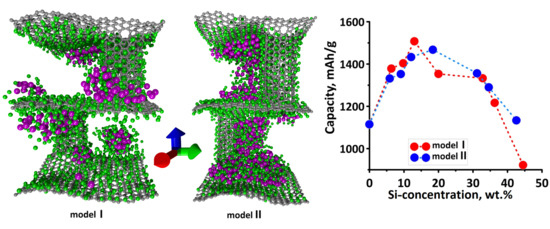Theoretical Study of a New Porous 2D Silicon-Filled Composite Based on Graphene and Single-Walled Carbon Nanotubes for Lithium-Ion Batteries
Abstract
1. Introduction
2. Materials and Methods
3. Results and Discussion
3.1. Atomistic Models
3.2. Lithiation
3.3. Delithiation
4. Conclusions
Author Contributions
Funding
Conflicts of Interest
References
- Wang, G.; Xu, B.; Shi, J.; Wu, M.; Su, H.; Ouyang, C.Y. New insights into Li diffusion in Li-Si alloy for Si anode materials: Role of Si microstructure. Nanoscale 2019, 11, 14042–14049. [Google Scholar] [CrossRef] [PubMed]
- Dash, R.; Pannala, S. RETRACTED ARTICLE: Theoretical Limits of Energy Density in Silicon-Carbon Composite Anode Based Lithium Ion Batteries. Sci. Rep. 2016, 6, 27449. [Google Scholar] [CrossRef] [PubMed]
- Nazir, A.; Le, H.T.T.; Min, C.-W.; Kasbe, A.; Kim, J.; Jin, C.-S.; Park, C.-J. Coupling of conductive Ni3(2,3,6,7,10,11-hexaiminotriphenylene)2 metal-organic framework with silicon nanoparticles for use in high-capacity lithium-ion batteries. Nanoscale 2019, 12, 1629–1642. [Google Scholar] [CrossRef] [PubMed]
- Tao, J.; Lu, L.; Wu, B.; Fan, X.; Yang, Y.; Li, J.; Lin, Y.; Li, Y.; Huang, Z.; Lu, J. Dramatic improvement enabled by incorporating thermal conductive TiN into Si-based anodes for lithium ion batteries. Energy Storage Mater. 2019, 29, 367–376. [Google Scholar] [CrossRef]
- Hosoya, K.; Kamidaira, T.; Tsuda, T.; Imanishi, A.; Haruta, M.; Doi, T.; Inaba, M.; Kuwabata, S. Lithium-Ion Battery Performance Enhanced by Combination of Si Thin Flake Anode and Binary Ionic Liquid System. Adv. Mater. 2020, 1, 625–631. [Google Scholar] [CrossRef]
- Tong, L.; Wang, P.; Fang, W.; Guo, X.; Bao, W.; Yang, Y.; Shen, S.; Qiu, F. Interface engineering of silicon/carbon thin film anode for high-rate lithium-ion batteries. ACS Appl. Mater. Interfaces 2020, 12, 29242–29252. [Google Scholar] [CrossRef]
- Hapuarachchi, S.N.S.; Wasalathilake, K.; Siriwardena, D.P.; Nerkar, J.; Chen, H.; Zhang, S.; Liu, Y.; Zheng, J.; Golberg, D.; O’Mullane, A.; et al. Interfacial Engineering with Liquid Metal for Si-based Hybrid Electrodes in Lithium Ion Batteries. ACS Appl. Energy Mater. 2020, 3, 5147–5152. [Google Scholar] [CrossRef]
- Galashev, A.Y.; Ivanichkina, K.A.; Katin, K.P.; Maslov, M.M. Computer Test of a Modified Silicene/Graphite Anode for Lithium-Ion Batteries. ACS Omega 2020, 5, 13207–13218. [Google Scholar] [CrossRef]
- Yan, M.-Y.; Li, G.; Zhang, J.; Tian, Y.-F.; Yin, Y.-X.; Zhang, C.-J.; Jiang, K.-C.; Xu, Q.; Li, H.-L.; Guo, Y.-G. Enabling SiOx/C Anode with High Initial Coulombic Efficiency through a Chemical Pre-Lithiation Strategy for High Energy Density Lithium-Ion Batteries. ACS Appl. Mater. Interfaces 2020, 12, 27202–27209. [Google Scholar] [CrossRef]
- Yin, Y.; Arca, E.; Wang, L.; Yang, G.; Schnabel, M.; Cao, L.; Xiao, C.; Zhou, H.; Liu, P.; Nanda, J.; et al. Non-Passivated Silicon Anode Surface. ACS Appl. Mater. Interfaces 2020, 12, 26593–26600. [Google Scholar] [CrossRef]
- Dimov, N.; Fukuda, K.; Umeno, T.; Kugino, S.; Yoshio, M. Characterization of carbon-coated silicon. Power Sour. 2003, 114, 88–95. [Google Scholar] [CrossRef]
- Yeo, B.C.; Jung, H.; Lee, H.W.; Yun, K.-S.; Kim, H.; Lee, K.-R.; Han, S.S. Atomistic Simulation Protocol for Improved Design of Si–O–C Hybrid Nanostructures as Li-Ion Battery Anodes: ReaxFF Reactive Force Field. J. Phys. Chem. C 2017, 121, 23268–23275. [Google Scholar] [CrossRef]
- Zhou, S.; Liu, X.; Wang, D. Si/TiSi2 Heteronanostructures as High-capacity Anode Material for Li Ion Batteries. Nano Lett. 2010, 10, 860–863. [Google Scholar] [CrossRef] [PubMed]
- Zheng, Y.; Kong, X.; Usman, I.; Xie, X.; Liang, S.; Cao, G.; Pan, A. Rational design of Pea-pod structure of SiOx/C in carbon nanofibers as high-performance anode for lithium ion batteries. Inorg. Chem. Front. 2020, 7, 1762–1769. [Google Scholar] [CrossRef]
- Ma, D.; Cao, Z.; Hu, A. Si-Based Anode Materials for Li-Ion Batteries: A Mini Review. Nano-Micro Lett. 2014, 6, 347–358. [Google Scholar] [CrossRef]
- Xie, C.; Xu, Q.; Sari, H.M.K.; Li, X. Elastic buffer structured Si/C microsphere anodes via polymerization-induced colloid aggregation. Chem. Commun. 2020, 56, 6770–6773. [Google Scholar] [CrossRef]
- Zhang, W.; Fang, S.; Wang, N.; Zhang, J.; Shi, B.; Yu, Z.; Yang, J. A compact silicon–carbon composite with an embedded structure for high cycling coulombic efficiency anode materials in lithium-ion batteries. Inorg. Chem. Front. 2020, 7, 2487–2496. [Google Scholar] [CrossRef]
- Kim, S.; Yoo, H.; Kim, H. Chemically anchored two-dimensional-SiOx/zero-dimensional-MoO2 nanocomposites for high-capacity lithium storage materials. RSC Adv. 2020, 10, 21375–21381. [Google Scholar] [CrossRef]
- Zhang, Y.; Hu, G.; Yu, Q.; Liu, Z.; Yu, C.; Wu, L.; Zhou, L.; Liqiang, M. Polydopamine Sacrificial Layer Mediated SiOx/C@C Yolk@Shell Structure for Durable Lithium Storage. Mater. Chem. Front. 2020, 4, 1656–1663. [Google Scholar] [CrossRef]
- Su, W.; Wan, R.; Liang, Y.; Zuo, Y.; Tang, Y. A Novel 3D Porous Pseudographite/Si/Ni Composite Anode Materials Fabricated by a Facile method. Dalton Trans. 2020, 49, 7166–7173. [Google Scholar] [CrossRef]
- Yang, X.; Yu, D.; Cao, B.; To, A.C. Ultrahigh Thermal Rectification in Pillared Graphene Structure with Carbon Nanotube–Graphene Intramolecular Junctions. ACS Appl. Mater. Interfaces 2017, 9, 29–35. [Google Scholar] [CrossRef] [PubMed]
- Banda, H.; Périé, S.; Daffos, B.; Taberna, P.-L.; Dubois, L.; Crosnier, O.; Simon, P.; Lee, D.; Paepe, G.-D.; Duclairoir, F. Sparsely Pillared Graphene Materials for High Performance Supercapacitors: Improving Ion Transport and Storage Capacity. ACS Nano 2019, 13, 1443–1453. [Google Scholar] [CrossRef] [PubMed]
- Peng, H.; Zhong, Y.; Zhang, X.; He, Y.; Wang, G. Percolating Film of Pillared Graphene Layer Integrated with Silver Nanowire Network for Transparent and Flexible Supercapacitors. Langmuir 2018, 34, 15245–15252. [Google Scholar] [CrossRef]
- Bi, L.; Yin, J.; Huang, X.; Wang, Y.; Yang, Z. Graphene pillared with hybrid fullerene and nanotube as a novel 3D framework for hydrogen storage: A DFT and GCMC study. Int. J. Hydrogen Energy 2020, 45, 17637–17648. [Google Scholar] [CrossRef]
- Mert, H.; Deniz, C.U.; Baykasoglu, C. Monte Carlo simulations of hydrogen adsorption in fullerene pillared graphenenanocomposites. Mol. Simul. 2020, 46, 650–659. [Google Scholar] [CrossRef]
- Duan, K.; Li, Y.; Li, L.; Hu, Y.; Wang, X. Pillared graphene as excellent reinforcement for polymer-based nanocomposites. Mater. Des. 2018, 147, 11–18. [Google Scholar] [CrossRef]
- Wang, C.-H.; Fang, T.-H.; Sun, W.-L. Mechanical properties of pillared-graphene nanostructures using molecular dynamics simulations. J. Phys. D Appl. Phys. 2014, 47, 405302. [Google Scholar] [CrossRef]
- Slepchenkov, M.M.; Shmygin, D.S.; Zhang, G.; Glukhova, O.E. Controlling the electronic properties of 2D/3D pillared graphene and glass-like carbon via metal atom doping. Nanoscale 2019, 11, 16414–16427. [Google Scholar] [CrossRef]
- Dimitrakakis, G.K.; Tylianakis, E.; Froudakis, G.E. Pillared Graphene: A New 3-D Network Nanostructure for Enhanced Hydrogen Storage. Nano Lett. 2008, 8, 3166–3170. [Google Scholar] [CrossRef]
- Wesołowski, R.P.; Terzyk, A.P. Pillared graphene as a gas separation membrane. Phys. Chem. Chem. Phys. 2011, 13, 17027–17029. [Google Scholar] [CrossRef]
- Wesołowski, R.P.; Terzyk, A.P. Dynamics of effusive and diffusive gas separation on pillared graphene. Phys. Chem. Chem. Phys. 2016, 18, 17018–17023. [Google Scholar] [CrossRef] [PubMed]
- Aradi, B.; Hourahine, B.; Frauenheim, T. DFTB+, a Sparse Matrix-Based Implementation of the DFTB Method. J. Phys. Chem. A 2007, 111, 5678–5684. [Google Scholar] [CrossRef] [PubMed]
- DFTB+. Available online: https://www.dftbplus.org/ (accessed on 21 July 2020).
- Glukhova, O.E. Molecular Dynamics as the Tool for Investigation of Carbon Nanostructures Properties. In Thermal Transport in Carbon-Based Nanomaterials, 1st ed.; Zhang, G., Ed.; Elsevier: Oxford, UK, 2017; pp. 267–289. [Google Scholar]
- Plimpton, S. Fast Parallel Algorithms for Short-Range Molecular Dynamics. J. Comput. Phys. 1995, 117, 1–19. [Google Scholar] [CrossRef]
- Senftle, T.P.; Hong, S.; Islam, M.M.; Kylasa, S.B.; Zheng, Y.; Shin, Y.K.; Junkermeier, C.; Engel-Herbert, R.; Janik, M.J.; Aktulga, H.-M.; et al. The ReaxFF reactive force-field: Development, applications and future directions. npj Comput. Mater. 2016, 2, 15011. [Google Scholar] [CrossRef]
- Wang, Y.; Shi, Y.; Sun, Q.; Lu, K.; Kubo, M.; Xu, J. Development of a Transferable ReaxFF Parameter Set for Carbon- and Silicon-Based Solid Systems. J. Phys. Chem. C 2020, 124, 10007–10015. [Google Scholar] [CrossRef]
- Hong, S.; van Duin, A.C.T. Atomistic-Scale Analysis of Carbon Coating and Its Effect on the Oxidation of Aluminum Nanoparticles by ReaxFF-Molecular Dynamics Simulations. J. Phys. Chem. C 2016, 120, 9464–9474. [Google Scholar] [CrossRef]
- Raju, M.; Ganesh, P.; Kent, P.R.C.; van Duin, A.C.T. Reactive Force Field Study of Li/C Systems for Electrical Energy Storage. J. Chem. Theory Comput. 2015, 11, 2156–2166. [Google Scholar] [CrossRef]
- Wasalathilake, K.; Hapuarachchi, S.; Zhao, Y.; Fernando, J.F.S.; Chen, H.; Nerkar, J.; Golberg, D.; Zhang, S.; Yan, C. Unveiling the Working Mechanism of Graphene Bubble Film/Silicon Composite Anodes in Li-Ion Batteries: From Experiment to Modelling. ACS Appl. Energy Mater. 2020, 3, 521–531. [Google Scholar] [CrossRef]
- Li, Y.; Qi, Y. Transferable Self-Consistent Charge Density Functional Tight-Binding Parameters for Li–Metal and Li-Ions in Inorganic Compounds and Organic Solvents. J. Phys. Chem. C 2018, 122, 10755–10764. [Google Scholar] [CrossRef]
- Oliveira, A.F.; Philipsen, P.; Heine, T. DFTB Parameters for the Periodic Table, Part 2: Energies and Energy Gradients from Hydrogen to Calcium. J. Chem. Theory Comput. 2015, 11, 5209–5218. [Google Scholar] [CrossRef]
- Shin, Y.K.; Sengul, M.Y.; Jonayat, A.S.M.; Lee, W.; Gomez, E.D.; Randall, C.A.; van Duin, A.C.T. Development of a ReaxFF reactive force field for lithium ion conducting solid electrolyte Li1+xAlxTi2−x(PO4)3 (LATP). Phys. Chem. Chem. Phys. 2018, 20, 22134–22147. [Google Scholar] [CrossRef] [PubMed]
- Giannozzi, P.; Andreussi, O.; Brumme, T.; Bunau, O.; BuongiornoNardelli, M.; Calandra, M.; Car, R.; Cavazzoni, C.; Ceresoli, D.; Cococcioni, M.; et al. Advanced capabilities for materials modelling with Quantum ESPRESSO. J. Phys. Condens. Matter 2017, 29, 465901. [Google Scholar] [CrossRef] [PubMed]
- Slepchenkov, M.M.; Shmygin, D.S.; Zhang, G.; Glukhova, O.E. Controlling anisotropic electrical conductivity in porous graphene-nanotube thin films. Carbon 2020, 165, 139–149. [Google Scholar] [CrossRef]
- Zhu, Y.; Li, L.; Zhang, C.; Casillas, G.; Sun, Z.; Yan, Z.; Ruan, G.; Peng, Z.; Raji, A.R.O.; Kittrell, C.; et al. A seamless three dimensional carbon nanotube graphene hybrid material. Nat. Commun. 2012, 3, 1–7. [Google Scholar] [CrossRef]
- Mahtout, S.; Belkhir, M.A. Structural, magnetic and electronic properties of Fe encapsulated by silicon clusters. Phys. Lett. A 2006, 360, 384–389. [Google Scholar] [CrossRef]
- Mahtout, S. Effect of Iron Atoms on the Properties οf Silicon Cage Clusters. Acta Phys. Pol. A 2013, 124, 688–694. [Google Scholar] [CrossRef]
- Wang, W.; Ruiz, I.; Ozkan, M.; Ozkan, C.S. Pillared graphene and silicon nanocomposite architecture for anodes of lithium ion batteries. In Proceedings of theSPIE NanoScience + Engineering 2014, San Diego, CA, USA, 17–21 August 2014. [Google Scholar]
- Wang, W.; Ruiz, I.; Guo, S.; Favors, Z.; Bay, H.H.; Ozkan, M.; Ozkan, C.S. Hybrid carbon nanotube and graphene nanostructures for lithium ion battery anodes. Nano Energy 2014, 3, 113–118. [Google Scholar] [CrossRef]
- Li, J.; Tritsaris, G.A.; Zhang, X.; Shi, B.; Yang, C.; Liu, S.; Yang, J.; Xu, L.; Yang, J.; Pan, F.; et al. Monolayer honeycomb borophene: A promising anode material with a record capacity for lithium-ion and sodium-ion batteries. J. Electrochem. Soc. 2020, 167, 090527. [Google Scholar] [CrossRef]
- Tritsaris, G.A.; Kaxiras, E.; Meng, S.; Wang, E. Adsorption and Diffusion of Lithium on Layered Silicon for Li-Ion Storage. Nano Lett. 2013, 13, 2258–2263. [Google Scholar] [CrossRef]
- Xiao, J.; Xu, W.; Wang, D.; Choi, D.; Wang, W.; Li, X.; Graff, G.L.; Liu, J.; Zhang, J.-G. Stabilization of Silicon Anode for Li-Ion Batteries. J. Electrochem. Soc. 2010, 157, A1047. [Google Scholar] [CrossRef]
- Yang, G.; Fan, X.; Liang, Z.; Xu, Q.; Zheng, W. Density functional theory study of Li binding to graphene. RSC Adv. 2016, 6, 26540–26545. [Google Scholar] [CrossRef]
- Liu, Y.; Yukawa, H.; Morinaga, M. First-principles study on lithium absorption in carbon nanotubes. Comput. Mater. Sci. 2004, 30, 50–56. [Google Scholar] [CrossRef]

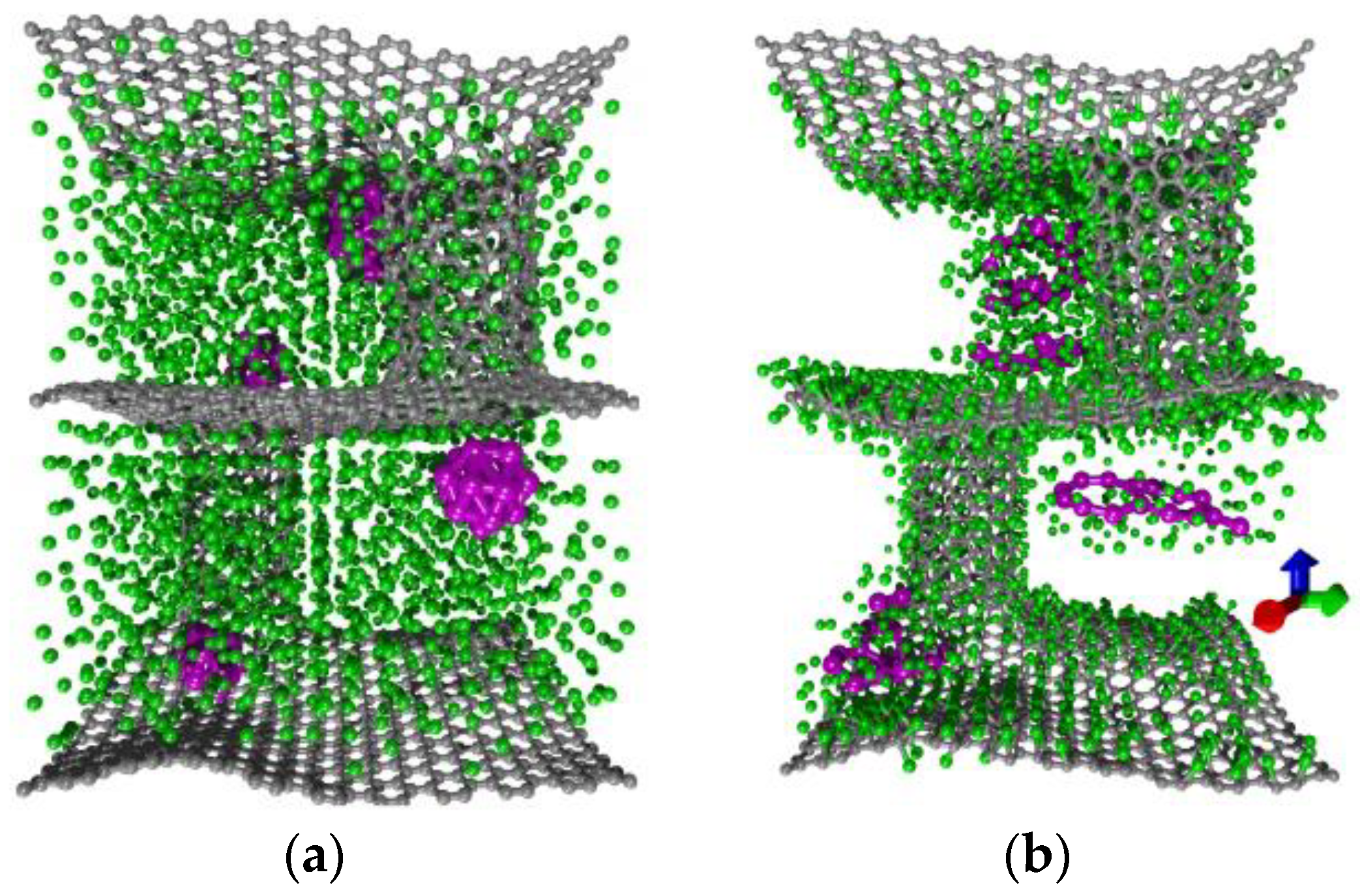
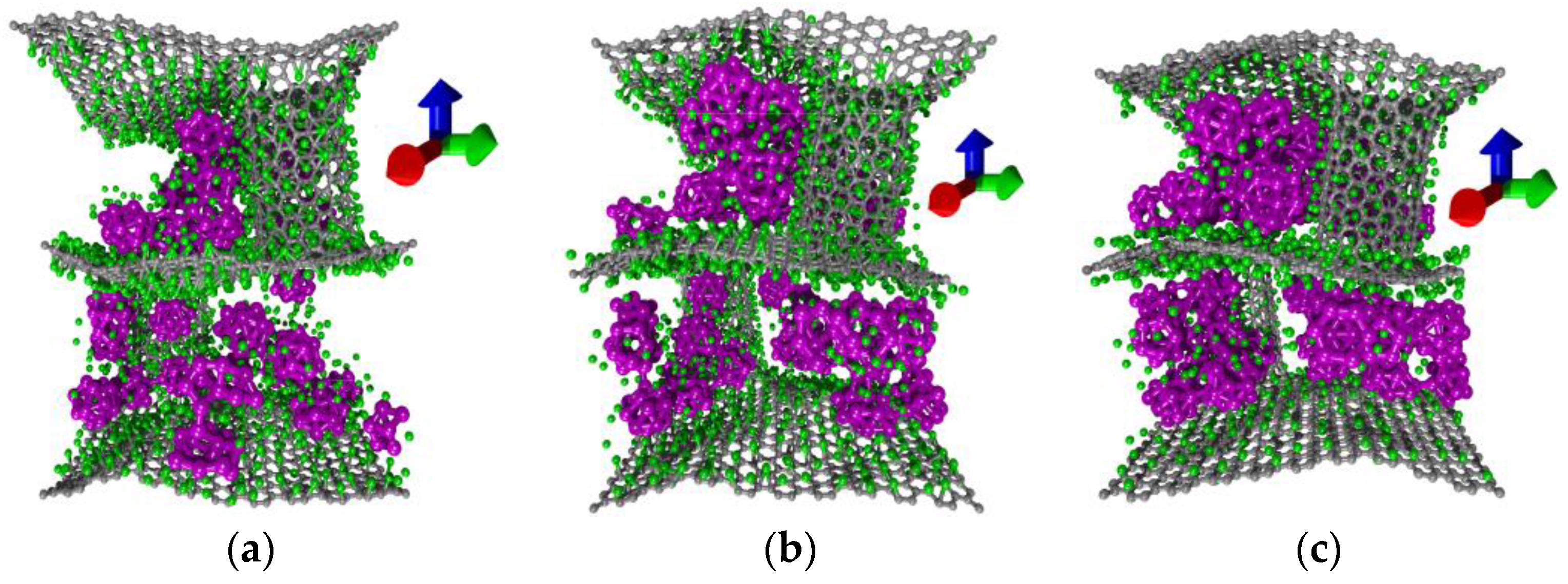
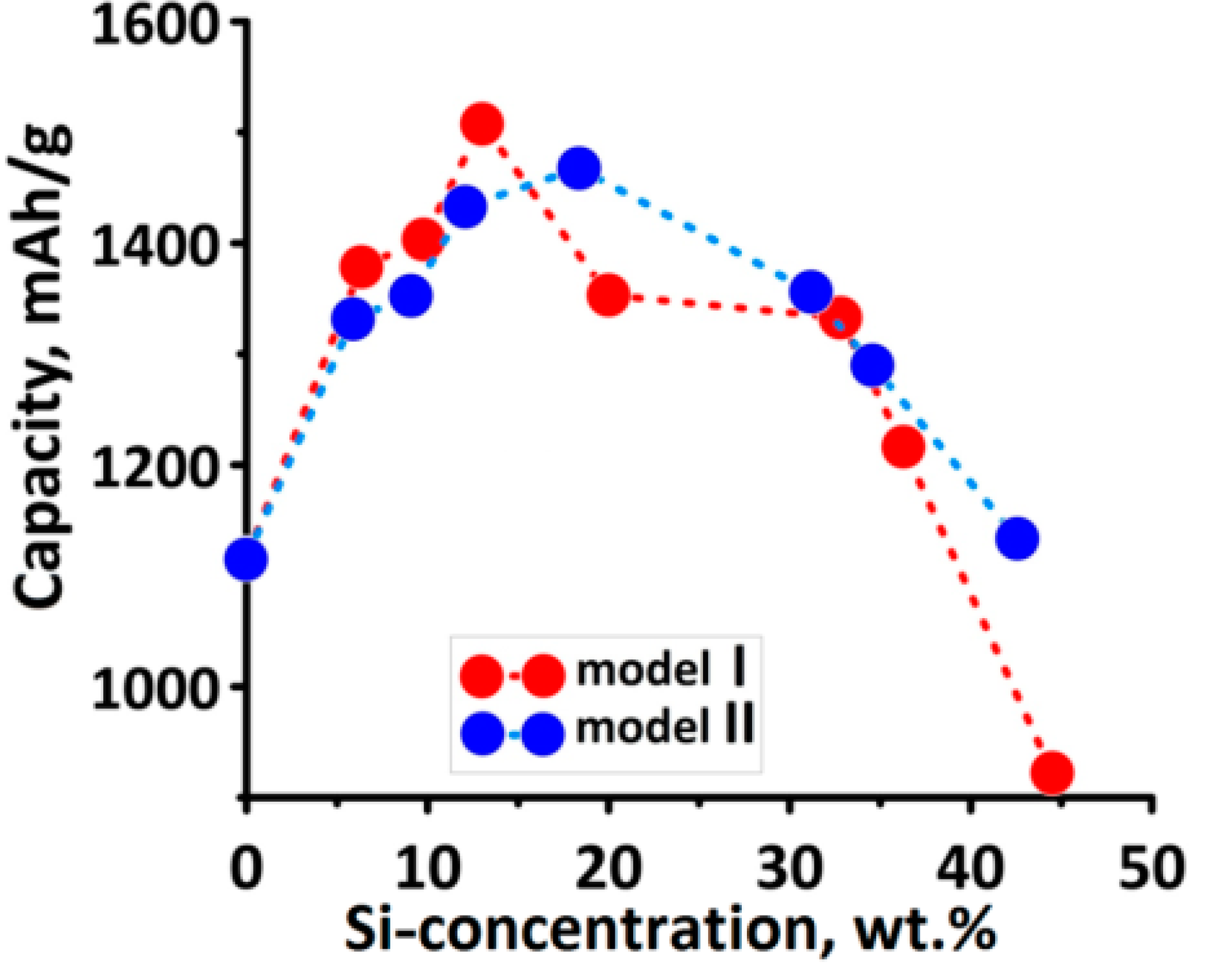
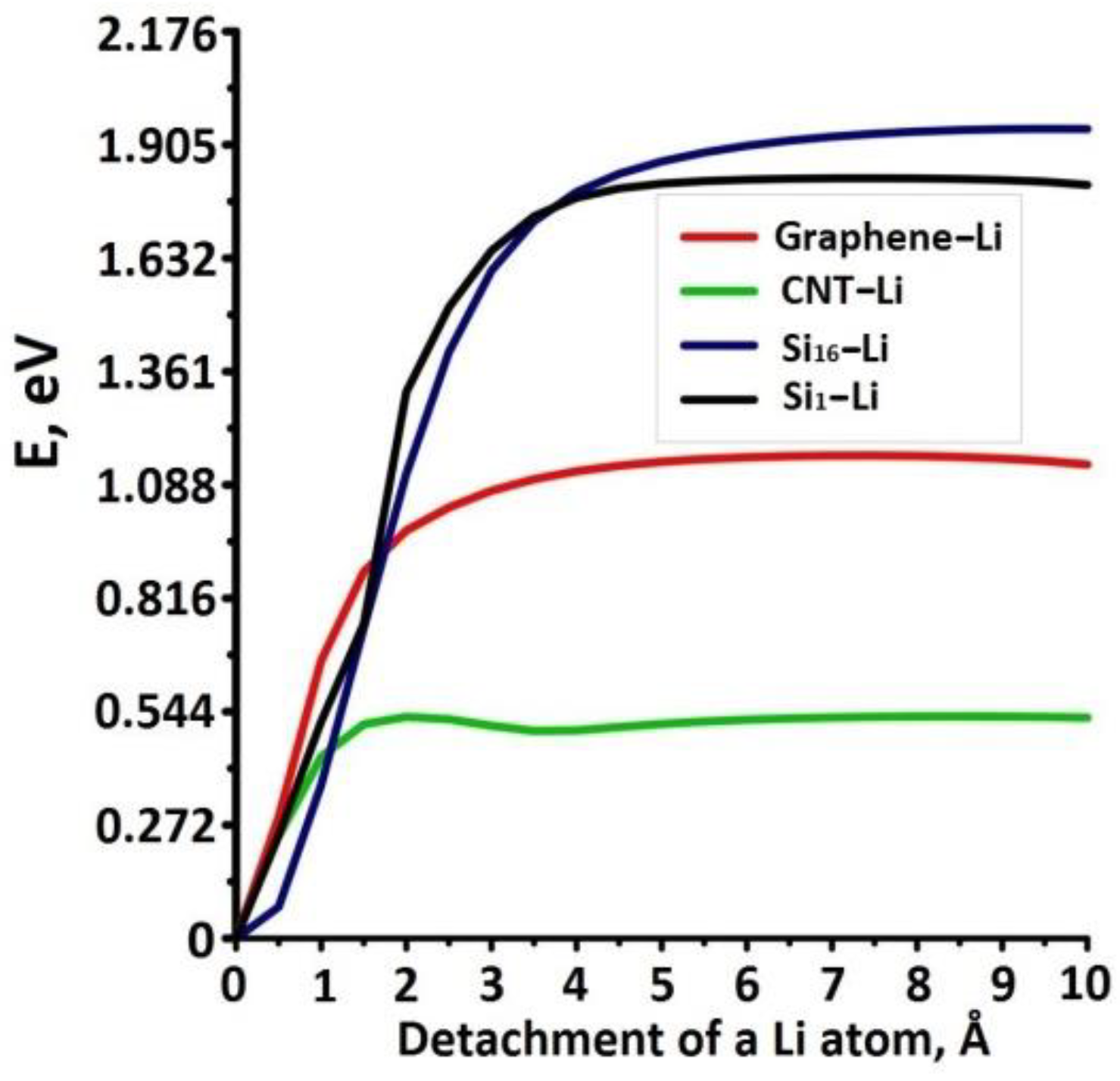
| Total Number of Atoms in the Supercell of the Composite | Number of Silicon Atoms in the Supercell (Si16 Cluster) | The Number of Lithium Ions in the Supercell | Mass Fraction of Silicon, wt.% | Li: C Ratio | Li: Si Ratio | Capacity of Pillared Graphene, mAh∙g−1 | Capacity of Si Clusters, mAh∙g−1 | Intermetallic Phase of Lix.xSi | Capacity of Electrode, mAh∙g−1 |
|---|---|---|---|---|---|---|---|---|---|
| 5544 | 80 (5) | 2704 | 6.3 | 1:2 | 4:1 | 1142.1 | 236.5 | 3.94 | 1378.6 |
| 5583 | 128 (8) | 2695 | 9.8 | 1:2 | 4:1 | 1136.4 | 267 | 2.86 | 1403.4 |
| 5581 | 176 (11) | 2645 | 13.0 | 1:2 | 2:1 | 1140.2 | 367.5 | 2.96 | 1507.7 |
| 5289 | 288 (18) | 2241 | 20.0 | 2:5 | 2:1 | 1137.7 | 215.5 | 1.13 | 1353.2 |
| 5387 | 576 (36) | 2046 | 32.8 | 2:5 | 1:1 | 1131.4 | 201.5 | 0.64 | 1332.9 |
| 5398 | 672 (42) | 1966 | 36.3 | 2:5 | 3:4 | 1012 | 204,5 | 0.59 | 1216.5 |
| 5129 | 944 (59) | 1419 | 44.5 | 2:9 | 1:2 | 796.2 | 126.2 | 0.3 | 922.4 |
| Total Number of Atoms in the Supercell of the Composite | Number of Silicon Atoms in the Supercell (Si16 Cluster) | The Number of Lithium Ions in the Supercell | Mass Fraction of Silicon, wt.% | Li:C Ratio | Li:Si Ratio | Capacity of Pillared Graphene, mAh∙g−1 | Capacity of Si Clusters, mAh∙g−1 | Intermetallic Phase of Li×Si | Capacity of Electrode, mAh∙g−1 |
|---|---|---|---|---|---|---|---|---|---|
| 6671 | 80 (5) | 3615 | 5.9 | 1:2 | 5:1 | 1138.8 | 193.9 | 3.44 | 1332.7 |
| 6675 | 128 (8) | 3571 | 9.1 | 2:3 | 4:1 | 1136.1 | 217.5 | 2.50 | 1353.6 |
| 6707 | 176 (11) | 3555 | 12.1 | 2:3 | 4:1 | 1134.2 | 299.7 | 2.59 | 1433.9 |
| 6725 | 288 (18) | 3461 | 18.4 | 2:3 | 3:1 | 1134.5 | 334.1 | 1.90 | 1468.6 |
| 6808 | 576 (36) | 3256 | 31.2 | 2:3 | 3:2 | 1131.9 | 225.4 | 0.76 | 1357.3 |
| 6833 | 672 (42) | 3185 | 34.6 | 1:2 | 3:2 | 1052.2 | 238.9 | 0.72 | 1291.1 |
| 6884 | 944 (59) | 2964 | 42.6 | 1:2 | 1:1 | 954 | 180.7 | 0.44 | 1134.7 |
© 2020 by the authors. Licensee MDPI, Basel, Switzerland. This article is an open access article distributed under the terms and conditions of the Creative Commons Attribution (CC BY) license (http://creativecommons.org/licenses/by/4.0/).
Share and Cite
Kolosov, D.A.; Glukhova, O.E. Theoretical Study of a New Porous 2D Silicon-Filled Composite Based on Graphene and Single-Walled Carbon Nanotubes for Lithium-Ion Batteries. Appl. Sci. 2020, 10, 5786. https://doi.org/10.3390/app10175786
Kolosov DA, Glukhova OE. Theoretical Study of a New Porous 2D Silicon-Filled Composite Based on Graphene and Single-Walled Carbon Nanotubes for Lithium-Ion Batteries. Applied Sciences. 2020; 10(17):5786. https://doi.org/10.3390/app10175786
Chicago/Turabian StyleKolosov, Dmitry A., and Olga E. Glukhova. 2020. "Theoretical Study of a New Porous 2D Silicon-Filled Composite Based on Graphene and Single-Walled Carbon Nanotubes for Lithium-Ion Batteries" Applied Sciences 10, no. 17: 5786. https://doi.org/10.3390/app10175786
APA StyleKolosov, D. A., & Glukhova, O. E. (2020). Theoretical Study of a New Porous 2D Silicon-Filled Composite Based on Graphene and Single-Walled Carbon Nanotubes for Lithium-Ion Batteries. Applied Sciences, 10(17), 5786. https://doi.org/10.3390/app10175786





